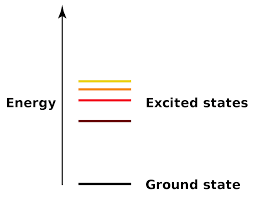
What is the difference between an atom’s ground state and an excited state?
Interpretation:
Difference between atoms’ ground state and an excited state.
Concept introduction:
Atoms have different energy states. The ground state and exited state, define energy level of the electrons present in atom.
Answer to Problem 61A
| Sr. No. | Difference between ground state and exited state of an atom | |
| Ground state | Exited state | |
| 1. | Ground state is the state in which all electrons in an atom are present in lowest possible energy level. | Exited state is the state in which electrons in an atom are present in higher energy level. |
| 2. | The electron in this state have zero energy | The electron in this state have high energy |
| 3. | The electrons of the atom are highly stable | The electrons of the atom are highly unstable |
| 4. | The distance between electrons and nucleus of the atom is least possible distance | The distance between electrons and nucleus of the atom is higher than ground state |
Explanation of Solution
Given information:
ground state and excited state of atom
The ground state is the lowest possible energy level that the electrons of an atom can have. The energy states for electrons are unique means that they have specific values only. The electrons of an atom can only move to another energy level after emitting or absorbing a particular amount of energy which is equal to the difference between two energy states. An excited state is an energy state of an atom in which the electrons of an atom is said to be at a higher energy level as compared to ground state.

The ground state is the lowest possible energy level that an atom can have. An excited state is state where the electrons of an atom have higher energy.
Chapter 5 Solutions
Chemistry: Matter and Change
Additional Science Textbook Solutions
Introductory Chemistry (5th Edition) (Standalone Book)
General Chemistry: Principles and Modern Applications (11th Edition)
Chemistry: A Molecular Approach
Organic Chemistry
Introductory Chemistry (6th Edition)
 ChemistryChemistryISBN:9781305957404Author:Steven S. Zumdahl, Susan A. Zumdahl, Donald J. DeCostePublisher:Cengage Learning
ChemistryChemistryISBN:9781305957404Author:Steven S. Zumdahl, Susan A. Zumdahl, Donald J. DeCostePublisher:Cengage Learning ChemistryChemistryISBN:9781259911156Author:Raymond Chang Dr., Jason Overby ProfessorPublisher:McGraw-Hill Education
ChemistryChemistryISBN:9781259911156Author:Raymond Chang Dr., Jason Overby ProfessorPublisher:McGraw-Hill Education Principles of Instrumental AnalysisChemistryISBN:9781305577213Author:Douglas A. Skoog, F. James Holler, Stanley R. CrouchPublisher:Cengage Learning
Principles of Instrumental AnalysisChemistryISBN:9781305577213Author:Douglas A. Skoog, F. James Holler, Stanley R. CrouchPublisher:Cengage Learning Organic ChemistryChemistryISBN:9780078021558Author:Janice Gorzynski Smith Dr.Publisher:McGraw-Hill Education
Organic ChemistryChemistryISBN:9780078021558Author:Janice Gorzynski Smith Dr.Publisher:McGraw-Hill Education Chemistry: Principles and ReactionsChemistryISBN:9781305079373Author:William L. Masterton, Cecile N. HurleyPublisher:Cengage Learning
Chemistry: Principles and ReactionsChemistryISBN:9781305079373Author:William L. Masterton, Cecile N. HurleyPublisher:Cengage Learning Elementary Principles of Chemical Processes, Bind...ChemistryISBN:9781118431221Author:Richard M. Felder, Ronald W. Rousseau, Lisa G. BullardPublisher:WILEY
Elementary Principles of Chemical Processes, Bind...ChemistryISBN:9781118431221Author:Richard M. Felder, Ronald W. Rousseau, Lisa G. BullardPublisher:WILEY





